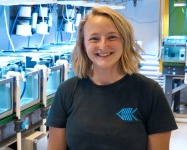

Michaela Miller
michaela.miller@utas.edu.au
PhD
College of Science and Engineering

Michaela Miller
michaela.miller@utas.edu.au
PhD
College of Science and Engineering
Ecological Fate of Microplastics in a Tropical Marine Environment
Michaela Miller grew up in the US, where she became fascinated by the marine world, and specifically she became passionate about how humans are impacting our global oceans. Following an undergraduate degree from Stony Brook University in New York, Michaela moved to tropical North Queensland in 2016, where she completed her Masters at AIMS@JCU, under the supervision of Dr. Frederieke Kroon, focusing on microplastic sample processing method development. Following, Michaela oscillated between casual contracts at AIMS and her PhD, which focused on the ecological fate of microplastics in a tropical marine environment and was under the supervision of Dr. Kroon, Dr. Cherie Motti and Dr. Mark Hamann.
Ecological Fate of Microplastics in a Tropical Marine Environment
2019 to 2023
Project Description
This project aimed to investigate the fate and impact of marine microplastics following entry into the food web of a tropical marine ecosystem. Model organisms, as well as their surrounding environment, were assessed to understand the baseline level of microplastic contaminations within each matrix and how they compare to one another, in an attempt to assess bioaccumulation and biomagnification trends. Additionally, laboratory experiments were conducted to uncover the pathways microplastics and commonly used chemical additives, may take within a multi-level food chain. This research aids in assessing the ecological impact that microplastics may have on the marine environment as a whole.
Project Importance
Since the mass production of plastic materials began in the 1950s, the global demand and usage of plastics has been on the rise, with a predicted increase in annual emissions of up to 53 million metric tonnes by 2030, should mitigation and management strategies not change. Marine plastic pollution, including microplastics (plastics < 5mm), is a growing global issue. Microplastics are of particular concern due to their small size and variable buoyancy, making them readily available and continually bioavailable to marine organisms across all trophic levels. The microplastics literature has been exponentially increasing over the past three decades, motivated by scientists, managers, and the general public wanting to know the extent, and mitigate the impact, of microplastic pollution. Despite increased research efforts, there are still major knowledge gaps related to the impact and fate of microplastics in the marine environment. This research project emphasises the persistence, and severity of the ecological issue surrounding plastic, and in particular microplastic, pollution.
Project Methods
The aim of this project is to understand the ecological fate and impact of microplastics within a tropical marine ecosystem (i.e., the GBR). Contained within the thesis are seven chapters outlining and addressing the key knowledge gaps:
Chapter 1: Presents an overview of the issues pertaining to microplastics in the marine environment and identifies the key knowledge gaps to provide a framework for the research.
Chapter 2: Examines whether current, published findings support the premise that microplastics and their chemical additives, bioaccumulate and biomagnify across a typical marine food web by means of a literature review and meta-analysis.
Chapter 3: Investigates the ingestion and retention of environmentally relevant concentrations of common polyester (PEST) microfibres by three marine species within a simple food web. Specifically, the exposure of copepods, mysid shrimp and moon wrasse to PEST microfibres (a) alone, (b) pre-adsorbed with bis(2-ethylhexyl) phthalate (DEHP), or (c) dosed alongside DEHP, was conducted to ascertain the influence of DEHP on their ingestion and retention of PEST microfibres.
Chapter 4: Assesses the potential of PEST microfibres to transfer through a typical 3-tier marine food web, comprising of copepods (level 1), mysid shrimp (level 2) and moon wrasse (level 3). The influence of DEHP on the ingestion and transfer of microfibres is also investigated.
Chapter 5: Establishes the MP contamination levels within a typical food web at two Central GBR reefs, Davies and Backnumbers Reefs. Copepods, benthic crustaceans (including mysid shrimp) and moon wrasse, as well as the surrounding sediment and water column were examined for the presence of microplastics allowing for the assessment of bioconcentration, bioaccumulation and biomagnification of microplastic contamination.
Chapter 6: Reveals the abundance and distribution of plastic contamination within the surface waters at the SS Yongala Shipwreck, located in the Central GBR. This chapter provides baseline contamination levels as well as details the physicochemical influences on plastic pollution in the local area and provides a foundation for a microplastics monitoring program.
Chapter 7: Presents an overview of thesis results and provides context for management of marine microplastic pollution in the GBR.
Project Results
Estimates for the Great Barrier Reef World Heritage Area (GBRWHA) show that the ecological risk can be substantial, with microplastic contamination widespread and continuous throughout all matrices examined. While bioaccumulation and biomagnification trends were not observed for global reports, local assessments indicate that microplastics are bioconcentrating in coral reef organisms. Laboratory experiments reveal biomagnification is possible, with trophic transfer being a prominent pathway of exposure. Alternative assessments of local in situ microplastic ingestion indicate biomagnification up a simple trophic food web is occurring. Microplastic contamination is heterogeneous, with variability across the GBRWHA, yet persistent in nature and subject to increase from physicochemical influences such as wind and extreme weather events. It was the goal of this research to build an empirical base to inform managers, policy makers and the general public about the severity of the issue of plastic pollution, in respect to the ecological fate of microplastics within a tropical marine ecosystem of great traditional, historical and ecological importance (i.e., the GBRWHA Science for Management Strategy).
Keywords
Pollution